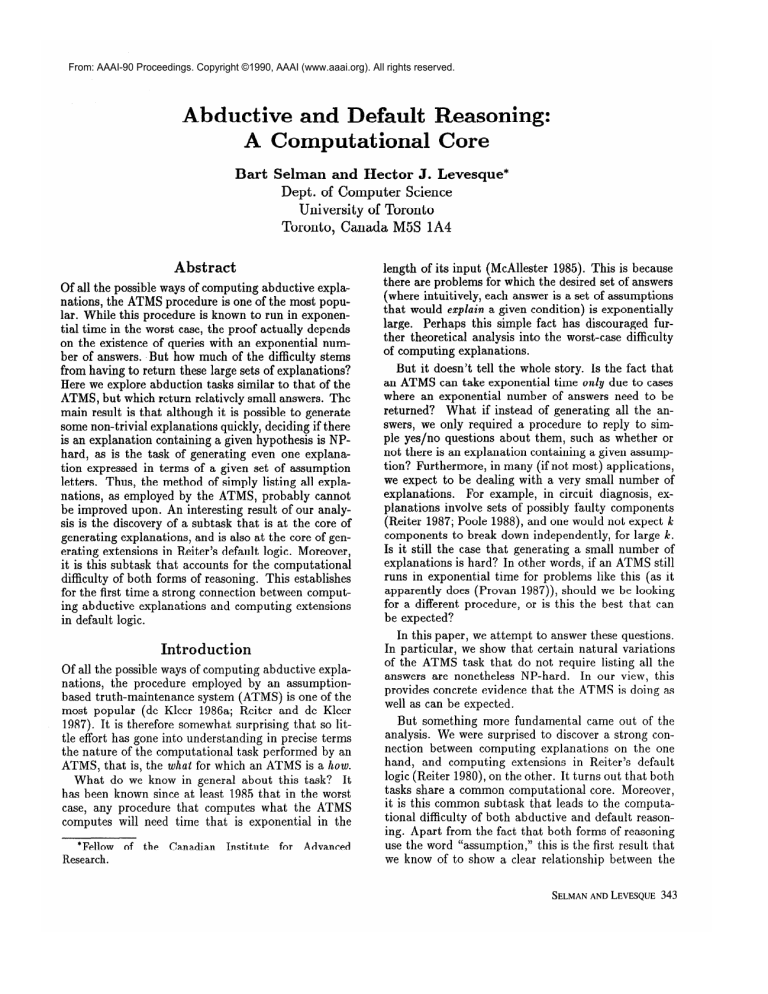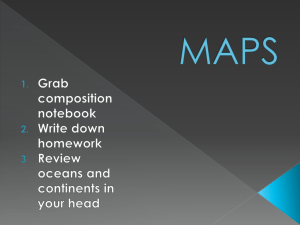
From: AAAI-90 Proceedings. Copyright ©1990, AAAI (www.aaai.org). All rights reserved.
Abductive and Default
A Computational
asoning:
Core
Bart Selman and Hector J. Levesque*
Dept. of Computer Science
University of Toronto
Toronto, Canada M5S lA4
Abstract
Of all the possible ways of computing abductive explanations, the ATMS procedure is one of the most popular. While this procedure is known to run in exponential time in the worst case, the proof actually depends
on the existence of queries with an exponential number of answers. But how much of the difficulty stems
from having to return these large sets of explanations?
Here we explore abduction tasks similar to that of the
ATMS, but which return relatively small answers. The
main result is that although it is possible to generate
some non-trivial explanations quickly, deciding if there
is an explanation containing a given hypothesis is NPhard, as is the task of generating even one explanation expressed in terms of a given set of assumption
letters. Thus, the method of simply listing all explanations, as employed by the ATMS, probably cannot
be improved upon. An interesting result of our analysis is the discovery of a subtask that is at the core of
generating explanations, and is also at the core of generating extensions in Reiter’s default logic. Moreover,
it is this subtask that accounts for the computational
difficulty of both forms of reasoning. This establishes
for the first time a strong connection between computing abductive explanations and computing extensions
in default logic.
Introduction
Of all the possible ways of computing abductive explanations, the procedure employed by an assumptionbased truth-maintenance system (ATMS) is one of the
most popular (de Kleer 1986a; Reiter and de Kleer
1987). It is therefore somewhat surprising that so little effort has gone into understanding in precise terms
the nature of the computational task performed by an
ATMS, that is, the what for which an ATMS is a how.
What do we know in general about this task? It
has been known since at least 1985 that in the worst
case, any procedure that computes what the ATMS
computes will need time that is exponential in the
*Fellow
Research.
of
the
Canadian
Institute
for
Advanced
length of its input (McAllester 1985). This is because
there are problems for which the desired set of answers
(where intuitively, each answer is a set of assumptions
that would explain a given condition) is exponentially
large. Perhaps this simple fact has discouraged further theoretical analysis into the worst-case difficulty
of computing explanations.
But it doesn’t tell the whole story. Is the fact that
an ATMS can take exponential time only due to cases
where an exponential number of answers need to be
returned? What if instead of generating all the answers, we only required a procedure to reply to simple yes/no questions about them, such as whether or
not there is an explanation containing a given assumption? Furthermore, in many (if not most) applications,
we expect to be dealing with a very small number of
explanations.
For example, in circuit diagnosis, explanations involve sets of possibly faulty components
(Reiter 1987; Poole 1988), and one would not expect Ic
components to break down independently, for large k.
Is it still the case that generating a small number of
explanations is hard? In other words, if an ATMS still
runs in exponential time for problems like this (as it
apparently does (Provan 1987)), should we be looking
for a different procedure, or is this the best that can
be expected?
In this paper, we attempt to answer these questions.
In particular, we show that certain natural variations
of the ATMS task that do not require listing all the
answers are nonetheless NP-hard. In our view, this
provides concrete evidence that the ATMS is doing as
well as can be expected.
But something more fundamental came out of the
analysis. We were surprised to discover a strong connection between computing explanations on the one
hand, and computing extensions in Reiter’s default
logic (Reiter 1980)) on the other. It turns out that both
tasks share a common computational core. Moreover,
it is this common subtask that leads to the computational difficulty of both abductive and default reasoning. Apart from the fact that both forms of reasoning
use the word “assumption,” this is the first result that
we know of to show a clear relationship between the
SELMANAND LEVESQUE 343
computational properties of these two apparently very
different forms of reasoning.
The rest of the paper is organized as follows. In the
next section, we review Reiter and de Kleer’s analysis
of the ATMS. Next, we show that while it is always
easy to find at least one non-trivial explanation, determining if there is one containing a given assumption,
or finding one that is expressed only in terms of a given
assumption set is NP-hard. In section 4, we consider
a weaker version of the ATMS task (which we call the
Support Selection Task), where explanations are not
required to be minimal, and show that it too is NPhard. In section 5, we briefly review the definitions
from Reiter’s default logic, and show that the problem
of computing an extension is a variant of the Support
Selection Task where we care about maximality instead
of minimality. It turns out that making a support set
minimal or maximal is easy; it’s finding one in the
first place that is hard. Finally, some conclusions are
drawn.
Abduction
In this section, we formally define what constitutes an
explanation as computed by the ATMS (Reiter and de
Kleer 1987). W e will assume a standard propositional
language L with propositional letters from the set P.
We will use p, 4, r, s, and t (possibly with subscripts)
to denote propositional letters. A clause is a disjunction of literals (a literal is either a propositional letter,
called a positive literal, or its negation, called a negative literal). We will represent a clause by the set of
literals contained in the clause. A clause is called a
unit clause if it only contains a single literal. A clause
is Horn if and only if it contains at most one positive
literal. A set of Horn clauses will be called a Horn
theory.
Definition 1 [Explanation] Given a set of clauses
C, called the background theory, and a letter q, an explanation for q is a minimal set of unit clauses LYsuch
that
1. CUa
b q, and
2. C U a is consistent.
For a discussion on the desirability of the above properties, see Levesque (1989).2 Instead of expressing explanations as sets of unit clauses, we will often give
the logical equivalent form consisting of the conjunction of the literals occurring in the clauses, e.g., we
write p A q A r instead of {{p), {q}, {r}}.
Example: Let C be the
conjunctions r A s and t
t the trivial explanation
in the other, non-trivial
set {{p},
{q), {p, 7, S, t)}.
The
are explanations for t. We call
for t; our interest lies of course
explanations.
The notion of explanation defined above, is somewhat more general than the one employed in the
2For a quite different definition of explanation,
gia (1983) and Allemang et al. (1987).
344 COMMONSENSE
REASONING
see Reg-
ATMS. The ATMS only computes a certain subset of
these explanations, namely those drawn from a distinguished subset of the propositional letters, called assumptions.
Assumptions stand for the hypotheses that
we are willing to consider in the explanations, such as
the possible failure of a component in circuit diagnosis.
Definition 2 [Formal Specification of the
ATMS] Given a set of Horn clauses C, a set of assumptions A C P, and a letter q, called the query, the
ATMS procedure computes the following set:
A[& A, q] = {(w 1 CYis an explanation for q containing
only letters from A).
The
explanations
in A[C, A, q] will be called
explanations. Note that when the
assumption set includes all symbols in the language,
every explanation is also an assumption-based one.
assumption-based
Computing
explanations
We will now consider the computational cost of generating explanations.
As is well-known, there may
be exponentially many explanations for a given letter
(McAllester 1985; de Kleer 198613); and therefore, listing all of them may require exponential time.3 However, this leaves open the question of what the complexity of finding some explanation is. In particular,
what is the complexity of finding a non-trivial one?
In case C contains arbitrary clauses, finding any explanation is easily shown to be NP-hard.4 However,
the following theorem shows that when C is a Horn
theory, a non-trivial explanation (if one exists) can be
computed efficiently.
Theorem 1 Given a set of Horn clauses C and a letter q, a non-trivial explanation for q can be computed
in time O(kn>, where k is the number of propositional
letters and n is the number of occurrences of literals in
c.
Here we only give an outline of the algorithm. Consider a clause in C of the following form: {ql, . . . , qk, q}
with k 2 0 (if no such clause exists, return “no nontrivial explanation”).
Now, clearly q1 A . . . A qk with
C implies q. Subsequently, try removing a letter from
this conjunction while ensuring that the remaining conjunction together with C still implies q (testing can
be done in linear time, using the Dowling and Gallier
(1984) procedure). Repeat this process until no more
letters can be removed.
If the remaining
conjunction
is
non-empty
and combined
with C is consistent, return
that
q and
one;
otherwise
repeat
the
consider
above
another
procedure.
clause
containing
When all clauses
31n fact, there may be exponentially
many assumptionbased explanations,
and therefore
the worst case complexity of the ATMS, which lists all of them, is clearly
exponential.
4Since explanations
only exist when C is consistent,
an
explanation
procedure can be used to test the satisfiability
of a set of clauses.
containing Q have been explored and no explanation is
found, return “no non-trivial explanation.”
It is clear that the above algorithm only generates
certain, very particular explanations - which ones depend on the way the background knowledge C is expressed. Hut if there are some non-trivial explanations
that are easy to find, could it be that in some sense
they are all easy to find, even if there are too many to
list? One way to look at this question is to consider
a procedure that generates only a single explanation,
but must return different ones for different arguments.
For example, if we can ask for an explanation containing the letters in 5’1 but not containing those in
&, clearly we can generate arbitrary explanations.5
Unfortunately, the following theorem show that there
can be no efficient procedure for this form of “goaldirected” abduction, even if the set 5’1 contains only a
single literal, and 5’2 is empty.6
the reduction, this result also holds when C consists of
an acyclic Horn theory.7
Finally, we consider the influence of an assumption
set as used in the ATMS. Recall that the assumption
set A is a distinguished subset of the propositional letters and that given a query q, the ATMS will generate only explanations that contain letters from among
those in A. Note that the assumption set again allows
one to select a certain subset of all possible explanations. This way of of selecting certain explanations is
related, but not identical, to the notion of goal-directed
abduction. The following theorem shows that the use
of such an assumption set dramatically increases the
complexity of finding a non-trivial explanation (compare with theorem 1):
Theorem 2 Given a setwof Horn clauses C and letters
p and q, the problem of generating
an explanation for
q that contains p is NP-hard.
The proof of this theorem is based on a modification
of the reduction used in the proof of theorem 2: add
the clause {s} to the background theory, and let the
assumption-set contain all letters of the form zY. Now,
an assumption-based explanation will consist of a subset of the letters in the assumption set, and as above,
this set will uniquely identify a path from s to t not
containing any forbidden pair. Again, the problem remains NP-hard even for acyclic theories.
This theorem shows that apart from the fact that
the ATMS may have to list an exponential number of
explanations, merely finding one of them may require
exponential time.
Finally, we consider the experimental observation,
reported by Provan (1987), that the ATMS can exhibit
exponential behaviour even if the background theory is
such that there are only a few assumption-based explanations for the query letter. Provan argues that such
restricted theories have practical significance, for example, in scene interpretation. We can now show that
in fact the intractability is inherent in the task, and not
simply caused by the particular procedure employed in
the ATMS:
The proof of this theorem is based on a reduction from
the NP-complete decision problem “path with forbidden pairs” (or PWFP) defined by Gabow, Maheshwari,
and Osterweil(l976).
An instance of PWFP consists of
a directed graph G = (V, E), specified vertices s, t E V,
and a collection C = {(al, bi), . . . . (ura,bn)} of pairs of
vertices from V. The question is: does there exist a
path from s to t in G that contains at most one vertex from each pair in C? This problem remains NPcomplete even if we only consider acyclic graphs.
Given an instance of this restricted version of PWFP,
we now construct a background theory C. Identifying
the vertices of the graph with propositional letters, C
contains the following clauses: (1) for each directed
-edge (x, y), the clause {zy,z, y} where xY is a new
propositional letter, and (2) for each forbidden pair
(ai, bi) , the clause (z&, & } . Now, consider an explanation for t that contain s. It can be shown that if such
an explanation exists, it will consist of a set of propositional letters of the form :y that uniquely identify a
path from s to t in the origmal graph (Selman 1990).
Moreover, because of the clauses in group (2)) such a
path goes through at most one vertex of each forbidden pair. Thus, we can reduce the PWFP problem to
goal-directed abduction.
Intuitively speaking, theorem 2 shows that certain
explanations will be hard to find , even if our background theory C is Horn. And, as can be seen from
5The set S1 could be used, for example, to identify components that have a high failure rate when doing circuit diagnosis. For a related approach,
see de Kleer and Williams
(1989).
‘For the purpose of this paper, and to keep the provisos
to a minimum, we assume that P#NP.
An excellent introduction to the basic concepts of computational
complexity
theory can be found in Garey and Johnson (1979).
a set of Horn clauses C, a set
of assumptions
A, and a query letter q, finding an
assumption-based
explanation for q is NP-hard.
Theorem 3 Given
Theorem 4 Given a set of assumptions
A, a query q,
and a set of Horn clauses C such that q has at most one
assumption-based
explanation, finding this explanation
is NP-hard under randomized reductions.
To prove this theorem we use a result by Vazirani
and Valiant (1988), who show that determining propositional satisfiability remains hard (unless NP = RP,
considered to be very unlikely) even if one guarantees
that the given instances of SAT has at most one satisfying truth assignment.
Since the reduction
from SAT to
7Given a Horn theory C, let G be a directed graph containing a vertex for each literal in C and an edge from any
vertex corresponding
to a letter on the left-hand side of a
Horn rule to the vertex corresponding
to the letter on the
right hand-side of that rule. A Horn theory is acyclic if and
only if the associated
graph G is acyclic.
SELMANANDLEVESQUE 345
PWFP and the reduction from PWFP to assumptionbased explanations are parsimonious (a’.e., the number
of solutions is preserved), it follows that even if we
guarantee that there is at most one assumption-based
explanation for the query letter, finding it still remains
hard. So, the problem of generating assumption-based
explanations even for such special restricted background theories remains intractable, and therefore the
ATMS procedure is doing as well as can be expected.
One remaining question is whether the problem is
still hard if we are guaranteed that there are only a few
explanations overall (including the non-assumptionbased ones) for the query. Note that we can always
generate at least one non-trivial explanation (see theorem 1); we conjecture however that generating O(n)
of them is again NP-hard (possibly under randomized
reductions), where n is the number of propositional
letters in the language.
The Computational
Core
We have shown that finding an assumption-based explanation is intractable, even when the background
theory C is an acyclic set of Horn clauses. In this
section, we will isolate a subtask, called the Support
Selection Task, which lies at the core of the computational difficulties.
Definition 3 [Support Selection Task] Given a set
of Horn clauses C, a set of letters A C P, and a letter
q, find a set of unit clauses cy, called a support set, such
that the following conditions hold:
I. c u (I! + q,
2. C U cy is consistent,
3. curcontains
and
only letters form A.
Note that an assumption-based explanation is simply a
minimal support set. We first consider the complexity
of the Support Selection Task:
Theorem 5 Given
and a letter q, finding
a Horn theory C, a set A C_ P,
a support set for q is NP-hard.
This result follows directly from a generalization of the
reduction used in the proof of theorem 3. Since the
reduction does not rely on finding a minimal set of
assumptions to support the query, any support set for
the query will identify a path that goes from s to t
containing at most one vertex from each forbidden pair.
Because an assumption-based explanation is a minimal support set, finding such an explanation is at least
as hard as finding support sets. Hence, the intractability of finding an assumption-based explanation is in
fact a direct consequence of theorem 5. Stated differently, in order to establish the intractability of finding
an assumption-based explanation, one need not use the
fact that explanations are minimal.
Furthermore, the minimality requirement does not
further increase the computational difficulty of the
task, as can be seen from the following argument. Consider a support set cy for q. We can minimize this set
346 COMMONSENSE
REASONING
by removing clauses from it while each time verifying
that the reduced set combined with C still implies q.
Since C is a Horn theory this can be done in polynomial time. Finally, note that the Support Selection
Task can be shown to be no harder than any problem
in NP, and thus neither is generating an assumptionbased explanation.
To summarize, the Support Selection Task is at the
core of the ATMS-style abduction task. In the next
section, we will see how this task also is at the core of
goal-directed default reasoning, thereby establishing a
computational connection between abductive and default reasoning.
Default
Reasoning
Default Logic, introduced by Reiter (1980), is one of
the more prominent formal proposals for representing and reasoning with default information. We will
first briefly define Default Logic (see Reiter (1980)
and Etherington (1986) for further details), and subsequently consider the complexity of default logic theories .
Reiter formalized default reasoning by extending
first-order logic with default rules. A default theory
is a pair (D, IV) w here D is a set of default rules and
W a set of ordinary first-order formulas. A rule is of
the form:
a!:p
Y
where g is the prerequisite,
y the conclusion,
and p
the justification of the rule, each of them formulas. A
rule is intuitively understood as meaning that if a is
known, and p is consistent with what is known, then
+ymay be inferred.
An extension is a maximal set of conclusions that
can be drawn from a theory. But care must be taken
that none of the justifications of the rules used in the
construction of an extension conflict with its final contents, and that every formula in the extension can in
fact be derived from W and the rules. The formal definition of an extension (from Reiter (1980), Theorem
2.1) is therefore rather complex:
Definition 4 [Extension] A set of formulas
extension for the theory (D, W)
fies the following equations:’
E.
=
W,
E*a+1
=
Th(Ea)
and for
a:/3
Y 1 I Y
E=
E is an
if and only if it satis-
i 2 0
u
E D,
cy E Ei,
and +
e E
>
U
Ea
a’=0
Note the explicit reference to E in the definition of
E. %+I. Th denotes logical closure.
8We assume that all formulas
not contain free variables.
are closed,
i.e.,
they
do
Computing
Extensions
Kautz and Selman (1989) give a detailed analysis of the
computational complexity of default reasoning based
on Reiter’s proposal. They consider a partially ordered space of more and less general propositional default logic theories . For each theory the complexity
is determined of the following tasks: finding an extension (credulous reasoning), generating an extension
that contains a given set of propositions (goal-directed
reasoning), and the problem of determining what holds
in all extensions of a default logic theory (slceptical reasoning). To avoid the difficulty of the consistency check
needed to determine whether a rule can be applied,
Kautz and Selman restrict the default theories to ones
in which the set of facts W, the prerequisites, the justifications, and the consequences each consist of a set
of literals. Here we will consider a relaxation of these
restrictions. In particular, we will allow W to contain
Horn clauses.
We will show that even for extremely simple default
rules and a Horn theory W goal-directed default reasoning is intractable, and that the computational difficulty is again appropriately characterized by the Support Selection Task. ’ To facilitate our discussion, a
rule of the form :p/p will be called an elementary default - these rules are the simplest possible defaults.”
We have the following result concerning goaldirected default reasoning:
Theorem 6 Given an acyclic Horn theory W, a set
of elementary
defaults D, and a letter q, finding
extension of (D,W)
that contains q is NP-hard.ll
an
This result strengthens a recent result by Stillman
(1989), who showed the task is NP-hard for arbitrary
Horn theories with general normal unary defaults. But
aside from strengthening Stillman’s result, our interest
in this result arises from the fact that the Support Selection Task lies again at the root of the computational
difficulty of the problem, as we will see below.
To prove theorem 6, we first consider the relation between goal-directed default reasoning and the Support
Selection Task. Note that if C is a Horn theory and
D a set of elementary defaults involving letters from
a set A, then each extension of (D, C) is of the form
Th(C U a), where CYis a set of unit clauses drawn from
A. Intuitively, (Y is the set of letters that are added to
C via the rules in D. We have the following theorem:
‘Determining
the complexity
of goal-directed
reasoning
for such theories was given as one of the central open problems in Kautz and Selman (1989).
“Using
the terminology
of Kautz and Selman (1989),
they are normal unary defaults with empty prerequisites
and positive consequences.
l1 Since an extension consists of an infinite set of formulas
because of the logical closure, we are only looking for a set
of unit clauses that represents an extension,
as described
below.
Theorem 7 Let C be a Horn theory, q be a letter,
A C P be a set of letters, and let D = (:p/p 1 p E A).
Then, Th(CUa)
is an extension of (D, C) that contains
q if and only if o is Q maximal support set of q.
This theorem follows from a more general result by
Reiter (1987). It follows that finding extensions of the
default logic theory that contains a given letter q, is at
least as hard as finding a support set for q. Thus, theorem 6 follows directly from the fact that the Support
Selection Task is NP-hard (theorem 5).
Furthermore, the fact that extensions correspond to
maximal support sets does not further add to the difficulty of computing extensions: given a support set,
one can simply try adding additional letters from the
assumption set while maintaining consistency, until a
maximal set is obtained. Thus, as for assumptionbased explanations, the Support Selection Task is the
difficult part of goal-directed default reasoning.
It is suggested in Kautz and Selman (1989) that goaldirected reasoning could be of use in resolution theorem provers that incorporate default information. Our
results here suggest that such an integration will most
likely run into computational difficulties. Much more
promising, are credulous reasoners that search for an
arbitrary extension. This task remains tractable for
relatively expressive default rules combined with Horn
theories (Selman 1990). By contrast, skeptical default
reasoning, i. e., determining what holds in all extensions of a theory, can be shown to be strictly harder
than goal-directed reasoning, and thus our intractability result carries over to skeptical reasoning.
Conclusions
In this paper, we have examined the problem of computing abductive explanations. We have shown that
given a Horn theory and a letter q, some non-trivial
explanation for q can be calculated in polynomial time.
However, goal-directed abduction or the use of an assumption set renders the problem intractable, even for
acyclic Horn theories. Thus, the exponential worstcase complexity of the ATMS is not just a consequence of having to return an exponential number of
answers; generating even one explanation containing
letters from the assumption set is inherently difficult.
It appears unlikely, therefore, that the efficiency of the
ATMS algorithm can be significantly improved.
This work also shows that there is a strong connection between computing explanations and computing
extensions in default logic. Our Support Selection Task
is at the core of both assumption-based abductive reasoning and goal-directed default reasoning. We need
to minimize support sets for the former, and maximize
them for the latter, but neither is hard for Horn theories. In both cases, the difficult task is deciding on an
appropriate set of assumptions to make.
Finally, given the difficulty of dealing with acyclic
Horn theories, this work suggests that we may not be
SELMANANDLEVESQUE 347
able to trade expressiveness for tractability in abductive reasoning. It may turn out that there are no interesting restrictions on the background theory that
could guarantee efficient abduction (for some class of
queries). This is quite unlike the situation with deductive reasoning, where there is a linear time algorithm
for propositional Horn theories (Dowling and Gallier
1984), and with default reasoning, where there are
polynomial algorithms for certain acyclic default theories (Selman and Kautz 1988; Kautz and Selman 1989).
If we want to produce explanations automatically, in ‘a
timely fashion, and over a wide class of inputs, there
may be no alternative to some notion of “approximate”
explanation, or perhaps some principled form of unsound or incomplete abduction (a proposal for which
is suggested in Levesque (1989)).12
Acknowledgments
This research was supported in part by a grant from
the Natural Sciences and Engineering Research Council of Canada. We thank Ray Reiter for bringing to
our attention the close relation between default reasoning and the ATMS, and for useful suggestions and
discussions.
References
Allemang, D., Tanner, M.C., Bylander T., and
Josephson, J.R. (1987) On the computational complexity of h pothesis assembly. Proceedings IJCAI87, Milan, f taly, 1987, 1112-1117.
de Kleer, J. (1986a) An assumption-based TMS, Artificial Intelligence, Vol. 28, #2, 1986, 127-162.
de Kleer, J. (1986b) Problem solving with the ATMS,
Artificial Intelligence, Vol. 28, #2, 1986, 197-224.
de Kleer, J. and Williams, B.C. (1989)
sis with behavioral modes. Proceedings
Detroit, MI, 1989, 1325-1330.
DiagnoIJCAI-89,
Dowling, W.F. and Gallier, J.H. (1984). Linear-time
algorithms for testing the satisfiability of ropositional Horn formulae. Journal of Logic 3 rogrumming, 3, 1984, 267-284.
Gabow, H.N., Maheshwari S.N, and Osterweil L. (1976).
Octtvo problems in the generation of prqgram‘test ’
IEEE
Trans. Software Engzneenng,
1976,
8 27-231.
Garey, M.R. and Johnson, D.S. (1979). Computers
and Intractability,
A Guide to the Theory of NPCompleteness.
New York: W.H. Freeman, 1979.
Kautz, H.A. and Selman, B. (1989) Hard
problems
for simple default logics. Proceedin s o the First
International
Conference on Knowle Llge
epresentaligogn_la;t Reasoning (KR-89),
Toronto, Ont., 1989,
Levesque, H.J . (1989). A knowledge-level
account of
12Recently,
it has been brought
to our attention
that
Provan (1988) h as independently
obtained complexity
results for the ATMS which are similar to our results, but
somewhat
weaker.
348
COMMONSENSE
REASONING
abduction.
Proceedings
1989, 1061-1067.
IJCA I-89,
Detroit,
McAllester, D. (1985). A widely used used
yg;F-maintenance
system.
MIT, AI-lab
MI,
memo,
Poole, b. (1988). A methodology for using a default
and abductive reasoning system. Technical report,
Dept. of Computer Science, University of Waterloo,
Waterloo, Ont., 1988.
Provan, G.M. (1987). Efficiency analysis of multiplecontext TMSs in scene representation. Proceedings
AAAI-87,
Seattle, WA, 1987, 173-178.
Provan, G.M. (1988). The Computational Complexit of Truth Maintenance System. Technical Report
U mversity
’
of British Columbia, Department
Sgll
of Computer Science, 1988.
Reggia, J. (1983) D’
lag nostic expert systems based on
a set-covering model. International
Journal of Man
Machine Studies, 19(5), 1983, 437-460.
Reiter, R. and de Kleer, J. (1980). Foundations of
assumption-based truth maintenance systems. Proceedings AAAI-87,
Seattle, WA, 1987, 183-188.
Reiter, R. (1987). A theory of diagnosis from first
principles. Artificial Intelligence,
32(l),
1987, 5796.
Selman, B. and Kautz, H.A. (1988) The Complexity
of Model-Preference Default Theories. Proceedings
o the Seventh Biennial
Conference
of the Canadfian Society for Computational
Studies of Intelligence (CSCSI-SS),
Edmonton, Alberta, 1988, 102109. Extended version to appear in Artificial Intelligence.
Selman, B. (1990) Tractable default reasoning. Ph.D.
Thesis, Dept. of Computer Science, University of
Toronto, Toronto, Ont. (forthcoming.)
Stillman (1989) Th e complexity of Horn theories with
normal unary defaults. Technical report, General
Electric Research and Development Center, Schenectady, N.Y., 1989.
Valiant, R.G. and Vazirani V.V. (1986) NP is as easy
as detectin unique solutions. Theoretical Computer
Science, # fi7, 1986, 85-93.





